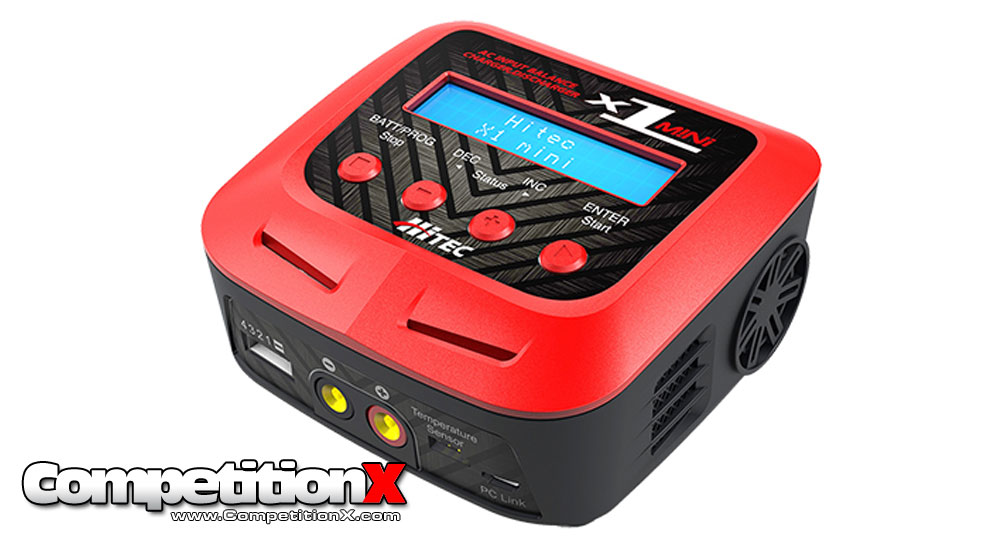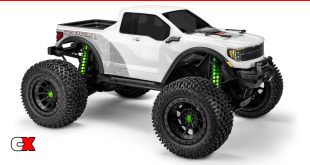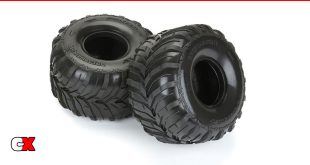
Everyone always says bigger is always better, but Hitec has challenged that phrase with the release of the X1 Mini, a new balance charger/discharger with a tiny little footprint. Even though it’s small, it includes big features like a battery meter, battery IR meter and PC Communications capability.
On top of all that, it has some pretty cool charger protection features; it has Over Temperature protection, Over Capacity and Over-Short Circuit Reverse Polarity protection.
Check out these specs:
• AC Input: 100-240 Volts AC
• Total Charge Circuit Power: 60 Watts AC Input
• Charge Current Range: 0.1 – 6.0 Amps
• Discharge Current Range: 0.1 – 2.0 Amps
• Discharge Current Power: 10 Watts
• Charges NiMH, NiCd, LiPo, LiHV, LiFe, Li-Ion and Lead Acid Batteries
• NiCd/NiMH Cell Count: 6-8 Cells
• LiPo/LiHV/Li-Ion/LiFe Cell Count: 2-4 Cells
• Pb Voltage: 6-12 Volts
• Net Weight: 0.68 lbs (310g)
• Dimensions: 4.41 x 4.17 x 2.05in (112 x 106 x 52mm)
#44241 Hitec X1 Mini AC Input Balance Charger
 [source: www.hitecrcd.com]
[source: www.hitecrcd.com]
 CompetitionX CompetitionX is the most up-to-date source for RC Car News, Reviews and Videos for Radio Control. We also have the most comprehensive Manual Database on the web.
CompetitionX CompetitionX is the most up-to-date source for RC Car News, Reviews and Videos for Radio Control. We also have the most comprehensive Manual Database on the web.




It appears that this charger does not come with a balancing board. What balancing board fits this unit, as from the picture it appears that the balancing plug is smaller than the regular size plugs
Hi Paul.
You’re right – the X1 does not include a balance board. I would look at getting one of these: http://hitecrcd.com/products/chargers/universal-balancing-board/product. It’s a universal one from Hitec that has the correct input plug size as well as having port for EH, TP, XH and HP balance plug types – from 2S to 6S. These are the only balance boards I use simply because of their universal design; I have a lot of different plug types on all my batteries.
What is the purpose of the balance board and do I need one?
I have the HiTEC x1MINI.
Hey William.
When using something like a 2S LiPo, each cell can discharge a little differently, ie, 1 cell could have 25% left in it while the other has 35%. When re-charging, the charger will pump juice into the battery, not taking into account that each cell has a different amount in it. This can cause issues, as you might suspect; one battery will hit 100% while the other is still trying to take a charge. The ‘full’ cell now enters a state of overcharging which can lead to the cell bursting and catching fire.
A balance board is used in conjunction with charging and relays information back to the charger about each cell. In our scenario, as one cell nears full charge, the charger will pull slow the rate to that cell until the other one catches up, bringing both to 100% at the same time.
So, in short, yes, you need one. It’s not just about safety, it also helps keep your batteries in good shape.
Tony – when I look at the HiTec board picture in the link above, and also look at a product page on Amazon which shows the actual wire connector ( http://tinyurl.com/jfygwem ), the plugs to me seem like a ‘standard’ 7 pin setup on both ends. The X1 seems to use a smaller (4 pin?) plug out, no ??
If true, what kind of cable connector would I be looking for ?? Something I’d have to make custom ? Is there a name for the actual style plug these Balance Adapters use ??
I assume the pins are numbered, and they correspond to the number of Cells correct ? The X1 mini says 2s-4s… likely thats why the plug is 4s ? And the part number above handles up to 7cells.
Thanks in advance for your help !
Rich
…. actually looking closer, that would be a 5 pin (4 for the 4s max, 1 for gnd) … right ??
thx
Rich
Hey Rich. Yes, the Hitec Universal Balancing Adapter does, in fact, use a 7-pin adapter. Unfortunately, because of this, it can’t be used with the X1 mini – in stock form. While I haven’t tried it, I think you can adapt a 5-pin adapter to the Balancing Adapter to make it work. The only thing I would pay attention to is the negative terminal on the adapter cable; it needs to insert in a certain position on the balance board. There might even be adapters with 7 pins on one end, 5 on the other. I didn’t see any on Hitec’s site but they may be available elsewhere.
As far as the number of pins, yes; since the X1 mini can only handle up to 4S, they use a 5-pin connector (1 negative, 4 positive).
The final option is to plug your battery straight into your charger; just pay attention to the polarity.